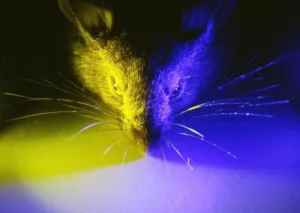At first look you might not think an article in the December 16th issue of Current Biology entitled “Cones Support Alignment to an Inconsistent World by Suppressing Mouse Circadian Responses to the Blue Colors Associated with Twilight” has anything to do with displays. But wait.

In the article, Tim Brown and his colleagues from the Centre for Biological Timing at The University of Manchester say
“Contrary to common beliefs, it is yellow rather than blue colors that have the strongest effect on the mammalian circadian system. This relationship aligns with natural shifts in the color of ambient illumination, detectable during twilight by mammals with di- and tri-chromatic visual systems.”
In other words, why would you expect bluish light from your cell phone to keep you awake when the natural transition at twilight is from the yellow of day to the blue of evening? Twilight is both dimmer and bluer than daylight, the authors say, and the body’s clock uses both inputs to tell it when it should sleep and when it should be awake. So, a display’s night mode that shifts the spectrum away from blue and toward yellow could be giving us exactly the wrong message.
Contrary to the majority opinion in the display industry blue light is more relaxing than warmer colors, according to recent research on mice from the University of Manchester. (Photo: University of Manchester)
This is an interesting argument but it requires experimental support, and that’s what the authors give us. The experiment was done on mice, with a lighting system that allowed the investigators to change the color while keeping brightness constant — important because declining brightness is also a cue that evening is coming. Indeed, brightness has a stronger effect on the mouse body clock than color, but the Manchester group showed that bluish colors have less effect on the mouse body clock than yellowish colors of the same brightness.
There is a reason why the circadian-rhythm and display communities have been pursuing the idea that blue keeps you from sleeping. (Some members of the popular press have even said blue light is “unhealthy.”) The body clock uses melanopsin, a light-sensitive protein in the eye, to measure brightness, and melanopsin is better at detecting shorter-wavelength (more blue) photons. From there, it was not an illogical jump to the idea that blue light might have a stronger effect on the circadian clock.
Tim Brown in a news release from the University of Manchester said,
“We show the common view that blue light has the strongest effect on the clock is misguided; in fact, the blue colours that are associated with twilight have a weaker effect than white or yellow light of equivalent brightness. [But] our perception of colour comes from the retinal cone cells and the new research shows that the blue colour signals they supply reduce the impact on light on the clock.”
In other words, the presence of blue moderates the effect of brightness.
“The cone system also plays a role, and they’re doing the opposite of what most people thought,”
says Brown.
Some “night modes” may also reduce brightness. That’s good, but you can also do that by yourself. Said Brown: “Our findings suggest that using dim, cooler, lights in the evening and bright warmer lights in the day may be more beneficial.”
So we know that blue light helps mice relax at night. But, says Brown,
“We think there is good reason to believe it’s also true in humans.” (KW)
Ken Werner is Principal of Nutmeg Consultants, specializing in the display industry, manufacturing, technology, and applications, including mobile devices, automotive, and television. He consults for attorneys, investment analysts, and companies re-positioning themselves within the display industry or using displays in their products. He is the 2017 recipient of the Society for Information Display’s Lewis and Beatrice Winner Award. You can reach him at [email protected] or www.nutmegconsultants.com.

